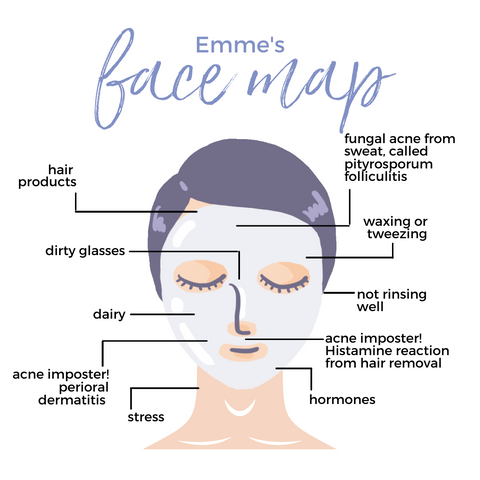Is There Any Truth to Chinese Face Mapping?
Sometimes called acne charts, acne maps, or pimple face maps, Chinese face mapping is a 3,000 year old practice that many turn to when dealing with breakouts.
The idea behind Chinese face mapping is that bodily imbalances and issues manifest as pimples, dryness, and redness on the face. In this method, each area of the face represents a different vital part of the body.
For example, the center of the forehead represents your small intestine. In this methodology, skin changes that happen on the forehead reflect the health of your small intestine.
The Science of Face Mapping
Is there any scientific evidence to back up face mapping? Well, no. Face mapping is not backed up by any scientific research or data. However, that doesn't mean it should be dismissed entirely, perhaps just looked at differently.
Emme's Face Map
Areas on the face do exist that have common triggers or causes, but it doesn't have to do with anything happening internally (hormonal acne being the exception).
So many clients come to me saying "I eat really clean, I did a detox cleanse and liver cleanse. I eat tons of super greens and I've done everything that face mapping says to do to clear my acne, but I still have acne."
This is because they are not treating the root cause of acne. You can read about what actually causes acne here.
While the location of acne can have some common triggers, there isn't currently evidence to suggest it has anything to do with a specific location in or on the human body. I have found that the common triggers are, more often than not, external factors. Here is my evidence-based version of face mapping:

The Hairline/Top of Forehead: Acne in this area is often due to hair products that are not acne-safe. Learn more about how hair products can affect your skin here.
The Forehead: Acne on the forehead is often caused by sweat. When it is a bunch of small non-inflamed bumps, you may be experiencing a fungal infection called pityrosporum folliculitis.
Directly Above or Below the Eyebrow: Pustules in close proximity to the eyebrow can sometimes be caused from waxing or tweezing (not to be confused with actual acne).
Between the Eyes/Bridge of the Nose: The friction of dirty glasses or sunglasses is a common culprit of acne here. Ensure you remember to clean your glasses regularly as they can harbor dirt, grime, and bacteria that can lead to breakouts.
Directly Next to the Ears: Pimples right up against the ear are usually caused by not rinsing your cleanser off thoroughly enough. The method in which you apply your toner can help solve this problem. Read about that here.
Cheeks: Acne on the cheeks is often caused by consuming too much dairy. Remember to avoid dairy in order to keep your skin consistently clear. Read more about the link between dairy and acne.
Above the Lip: Pustules and breakouts above the lip are often not acne, but rather caused by a histamine reaction from removing hair.
Around the Mouth: This red rash is shaped almost like parentheses around the mouth, or a goatee, and is often confused for acne. This is an acne imposter called perioral dermatitis.
Chin and Jawline: Acne on the chin and jawline is the one exception. Acne here is most often caused by hormonal fluctuations in the body, but rest assured, it can be treated with a consistent skincare routine.
Sides of the Neck: When acne appears on the sides of the neck, it is often triggered by stress. Stress affects the skin, and acne. You can learn more about how stress does this here.
So What Does My Acne Mean and How Do I Treat It?
If you are experiencing acne that is more stubborn in one area of the face than another, know that that is very common! There are likely many factors that are at play here, as you can see in my face map.
Please take my free consultation so we can take a look at what is going on, together. Though the face map above is what I often see, it doesn't mean that's 100% the case with your skin, which is why the consultation is so important!
-
Posted in
Skincare Education